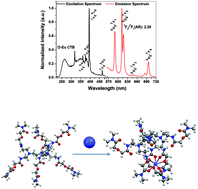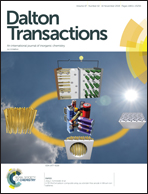A diglycolamide-functionalized TREN-based dendrimer with a ‘crab-like’ grip for the complexation of actinides and lanthanides†
Abstract
A generation 1 dendrimer, based on tris(2-aminoethyl)amine (TREN), containing six diglycolamide (DGA) pendent arms (termed TREN-G1-DGA) was synthesized and evaluated for the extraction of actinides and fission product ions. Solvent extraction studies indicated preferential extraction of Eu3+ over Am3+ with a separation factor value of ca. 4.5 in line with the extraction behaviour of multiple DGA ligands in previous reports. The distribution values of Am3+ and Eu3+ were about 12 and 9 times higher, respectively, than those obtained in the case of TREN-DGA using the 1 × 10−3 M ligand in 5% iso-decanol/95% n-dodecane at 3 M HNO3. The 1 : 1 (M : L) extracted species suggested ‘inclusion’ complex formation where more than one DGA moiety participates in the complex formation. The extracted species were devoid of any inner-sphere coordinated water molecules as confirmed by luminescence spectroscopy. The structure of the complex was also studied by DFT computations and EXAFS which suggested binding of three DGA arms around the central metal ion in the absence of any inner-sphere nitrate ions.



 Please wait while we load your content...
Please wait while we load your content...